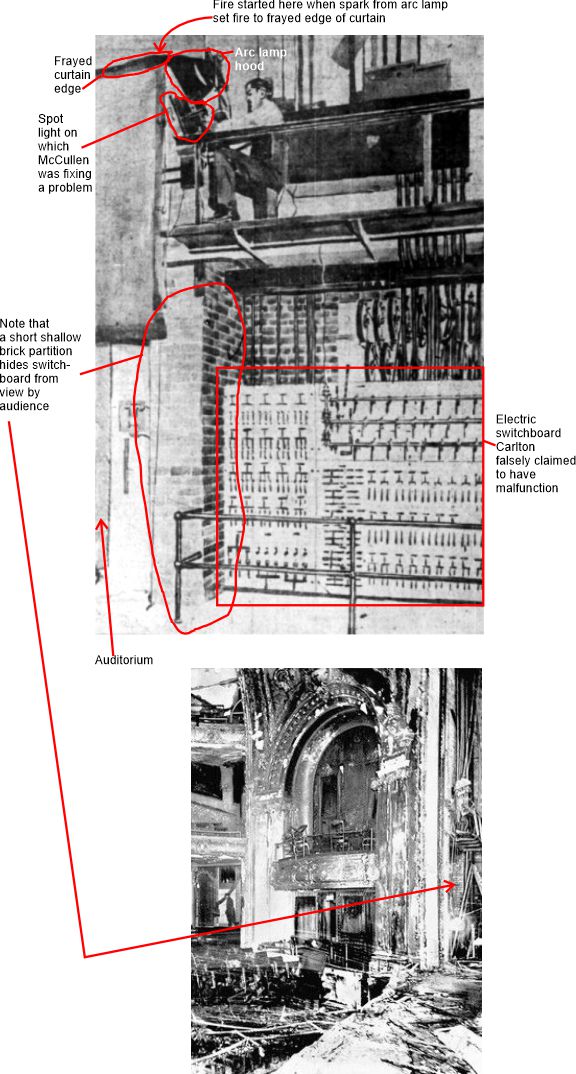|
Stage manager William Carlton asserted that he had seen
sparks shooting out of the electrial switchboard that
was located directly beneath the carbon arc lamp that
started America's worst theater fire. (See photos
below.) The scene in question took place on
December 30, 1903, at the Iroquois Theater in Chicago.
Police and newspapers knew Carlton's early statements
were "mistaken" because other workers reported seeing
Carlton at the front of the house, not on the stage,
making it impossible for him to have seen the sparking
switchboard. Carlton would later change his recollection
and testify that he was at the front of the house. If he
recanted his claims about observing sparks, it was not
reported.
Carlton wasn't the only one to confidently shade the
truth when questioned by authorities. House stage boss
James Cummings knew just what happened on the
stage — though other stage workers put him at a
nearby hardware store when the fire broke out.
Carlton laid blame on the house switchboard and on the
Iroquois stage manager. Cummings, an employee
of the house, blamed the traveling theater company
people and equipment. Though probably inevitable
under the circumstances, the combative relationship
between the traveling company and Iroquois Theater
personnel must have been exasperating for investigators
and jurors trying to assemble an accurate picture of what
happened.
|
|
|
Chicago authorities moved quickly to ensure that members of the traveling
theatrical company, potentially valuable witnesses about
circumstances before and during the fire, were unable to
follow through on a rumored scheme to depart the city
during the night. As stage manager for the Mr.
Bluebeard company, William T. Carlton (1863–1930)*
was one of the first of twelve theater personnel to be
arrested and held.
The night after the fire, assistant police chief
Herman Schuettler assured
coroner Traeger that there would not be a problem
with vanishing chorus girl witnesses. Their
clothing was burned up in the fire and the man who
controlled their pay, Carlton, was in jail.
After questioning, Carlton was released on $5,000 bond
with an agreement he would testify in the coroner's
inquest on January 21, 1904. He was not then held
over for the later grand jury inquest.
Rabbit hole
In court testimony, Carlton said that a month before
the fire, during the premier performance of Mr.
Bluebeard, the fire curtain had snagged on the
side lamp reflector,, tearing a small piece of the
curtain. Thereafter men were stationed on either
side of the proscenium arch to make sure the fire curtain
cleared the lamp strips. Newspaper reports did not
disclose whatever detailed testimony may have been given
about the role of the fabric tear in the fire curtain.
In one session of questioning Carlton said he and
Iroquois stage manager Cummings discussed the situation
and Carlton devised the solution of stationing men on
either side of the proscenium opening, going on to imply
that those men abandoned their posts when the fire broke
out. Since Carlton was at the front of the house
and not on the stage, he was not in a position to know
whether the men were at their posts, no more than he'd
been able to see sparks from the switchboard. In
testimony before the coroner's inquest, Carlton said the
entire solution and failure fell upon house man
Cummings.
According to an Iroquois house light operator, however,
Carlton's description of the two-man solution to the
curtain/lamp fixture problem, whomever's idea it was,
sounded better in theory than it worked in practice.
H. Hill said Carlton's relegation was ad hoc, assigned to any worker
who happened to be nearby, usually his assistant,
William Plunkett. (Plunkett was also the man who urged
his co-workers to take a bunk before the coroner's
inquest.)
Carlton's bio
William Carton had immigrated to the U.S. from Canada
at age twenty in 1883. His family lived in Queens
while he was the road with the Mr Bluebeard
company. They consisted of two daughters and a wife of 17
years, Oriana Lois LeMoyne (1864–).
I was not able to find William and his family after
1904. He was too young to retire but
employment in his craft may have become difficult
after all the negative Iroquois publicity. In
the 1900 census he had described himself as an actor,
suggesting that stage management wasn't his first
choice.
|
 |

Enlarge
|
